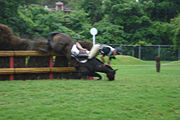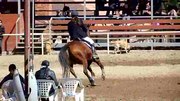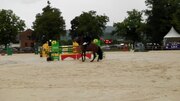Disobedience (horse)
A disobedience in horses includes general insubordination, and the refusal of a hindrance.
On pasture heard the storms of which, Bucking, bucking, kicking and climbing, from joy of movement or from certain social situations out of the natural behavior. In the hand, under the rider or in front of the car, these behaviors are undesirable and sometimes dangerous. It is therefore the aim of every horse training to control such behavior in handling. Some of these behaviors are shown with appropriate training in high school .
Go through
Runaway is an uncontrolled storming of a horse while riding or driving .
Usually it is either excessive joy in running or actually an escape reaction . The excessive joy of running, especially with young horses, can be dampened by parades .
The escape reaction, in which the horse panics and as a result no longer reacts normally, is more dangerous . Because of the panic, it is blind to danger and can easily injure itself from obstacles. Normal parades no longer get through to the horse under these circumstances. One can try to steer the horse into a narrowing circle and eventually bring it to a stop.
Sometimes a horse will storm off to evade a task. This can be due to the fact that the horse is not sufficiently well trained and physically or mentally not up to the task at hand.
Buck
When bucking (also bucking ), the horse or bull lowers its head and lifts its hindquarters into the air, usually the animal also kicks out its hind legs.
When riding, it is uncomfortable if the rider cannot follow the movement and therefore either falls back on the horse or falls off the horse. Here, too, the cause can be based on excessive zest for life, evasive behavior or fear. The evasive behavior can be due to incorrect or insufficient training, or to physical reasons (overload, health problems, saddlery, clumsy rider who hurts the horse in the back).
The croupade shown by the Cadre Noir in Saumur is a knockout where the forehand stays on the ground. The ballotade shown by the Spanish Riding School in Vienna is the horse jumping up on the spot and a preliminary stage to the caper .
Knock out
When striking, the horse , donkey or mule lifts both hind legs and lashes backwards. This behavior can be shown out of a zest for life, for example when a foal storms away in the pasture . It can be shown in conflict with other horses, usually as a defense when the horse feels harassed. The kicking out is mostly used as a warning. However, if a horse kicks out deliberately, it is very dangerous, especially if it has horseshoes on the back.
Climb
When climbing , the horse lifts the forehand off the ground, as in the levade , pesade or in the circus .
Uncontrolled climbing is very dangerous, however, as the horse can flip over backwards and bury the rider under itself. Therefore, any attempt to climb by safety-conscious horse people is immediately stopped by energetic forward riding. Only when a horse is trained far, in high meeting with good Hankenbeugung, pure rhythm , released and peppy piaffes , can begin levadas.
refusal
The horse refuses if it stops in front of an obstacle, backs away, runs sideways or against it without overcoming it. Refusal can cause a rider to fall from the horse or the horse can run into the obstacle. A refusal can still be safer if, for example, the obstacle was not approached properly and the jump does not fit.
An obstacle that is too difficult for a horse should not be required of it. Reasons for a refusal can be the wrong approach (too close, not close enough, wrong speed, too little swing, insecurity on the part of the rider), a wrong approach or insufficient training of the rider or horse. The horse may not be physically able to cope with the obstacle, for example due to poor training condition, health problems or inadequate fitness . The horse may have had a bad experience jumping, such as a hard hand or poor sitting position when landing, and therefore has insufficient confidence in its rider. Then jumping does not give the horse any pleasure, it becomes "angry" and tends to refuse. It is difficult to regain the trust of an acid horse. A bad rider can train his horse to refuse by regularly causing the horse to refuse using the wrong riding technique. The horse becomes insecure and loses the fun of jumping. Such a horse is called sour.
Line catch
"Liners" are driving forces , thereby notice that when they drive try the line between tail pinch and buttocks and then tear down. This makes steering the wagon much more difficult . This can lead to dangerous situations and accidents. The ruling on the linen catcher case is a case study that explains the requirements for negligence in jurisprudence .
Disobedience in trials
In equestrian tests , disobedience by the horse is assessed differently.
Show jumping exams
The term disobedience in show jumping includes the following:
- refusal
- Breaking out: running sideways past an obstacle
- Resilience: Resentful behavior anywhere on the course
- volte
In international jumping competitions , a second disobedience leads to the pair being eliminated. Different rules sometimes apply to national tournaments. In Germany, a couple receives 8 penalty points for the second disobedience. Only the third disobedience leads to the departure of the participant. If you are eliminated because of disobedience, an additional jump in obedience may be completed. Usually the simplest jump in the course that the couple can safely master is chosen.
versatility
In the cross-country ride of an eventing test , a refusal is punished as an obstacle error with 20 penalty points. The obstacles must be jumped in the intended direction and order. In the case of a combination of obstacles, both jumps must be jumped one after the other without riding a volte in between. If the test is ended after a refusal, the couple is allowed to master an additional obedience jump to prevent the horse from leaving the tournament with a bad memory.
Serenity test
A serenity test is inconsistent if, for example, the horse has to be brought several times to a tarpaulin on the ground before it crosses it.
Examples
Training a horse that shies away from water by breaking the task down into simpler steps. Here it is first used to a tarpaulin.
Resistance at a mass sporting event : the horse refuses to go any further, it shies away from something on the ground.
Correct behavior of a rider in the event of a refusal. The behavior of the horse (ear play, released, calm tail) shows that there is generally a good relationship of trust between rider and horse and that the horse is satisfied.
Unriding behavior in the event of a refusal (time-delayed multiple hitting with backstroke), which according to the FEI and FN regulations must lead to disqualification. It would be correct to simply tap the whip on the shoulder immediately. The behavior of the horse (tail whipping, pinched tail, lower neck, crawling back) shows a disturbed relationship of trust between rider and horse.
Web links
- Video of a refusal at 5:00 min. The horse previously ran a difficult dressage test. After it had the opportunity to adjust to jumping with a small jump, it jumped without any problems.
Individual evidence
- ↑ Uta Helkenberg: CCI4 * Burghley ended prematurely for Michael Jung. In: Pferd Aktuell September 2, 2017.
- ↑ FEI regulations "Jumping Rules", 26th edition, effective January 1, 2018 , (PDF; 1.1 MB), Article 219 ff
- ↑ Special LPO 2018 - News on the course: General - Time errors . In: St. Georg . January 2018, p. 71 .
- ^ Adelheid Borchardt, Maike Hoheisel: Rio 2016: Ahlmann and Deußer together in ninth place. In: Horse News. 19th August 2016.
- ↑ Guidelines to Eventing Rules 2018 art. 549.3.2, Diagrams of Cross Country Obstacles and Faults, Latest update: January 16, 2018 , FEI
- ↑ FEI regulations "Eventing Rules", 25th Edition effective January 1, 2018 , (PDF; 800 kB), Article 549.1 Refusal
- ↑ Guided GHP - For beginners. In: Cavallo .
- ↑ Serenity test for sport and leisure horses , published by Cavallo and FN , 2012













